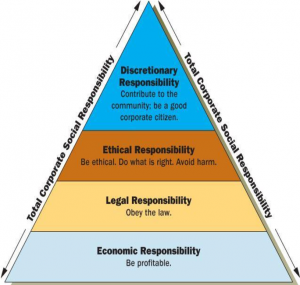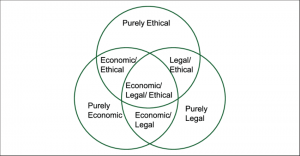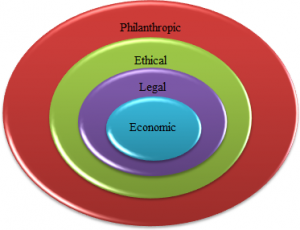5 Firms in Society
Learning Objectives
- Define why firms exist
- Introduce market failures
- Identify three different models of corporate social responsibility
Purpose of Firms
Why do firms exist? The short answer is that firms exist because firms are useful. They serve a purpose, in helping to organize the resources needed to answer many of the economic questions. Firms are where goods and services are produced and sold, in a modern economy, so they are where the questions “How much should be produced?”, “How should goods be produced?” and “For whom shall they be produced?” are answered.
However, in a market system without any checks-and-balances, as we shall see, these questions can have answers that only benefit a few, with consequences that are borne by the many. For example, electricity production is most efficiently achieved by a single firm (How should, and How much). However, this type of production is a monopoly, and when there is only a single seller, there is an incentive to charge the consumer higher prices. Since electricity is not a luxury good, but rather a necessity in modern society, we regulate the utility market to ensure prices stay lower. There was a time that the Internet was NOT considered an essential good, but as the COVID-19 pandemic has shown us, perhaps we should change our opinions on this. This is an example of market failures, a topic we will explore in more detail in Chapter 10.
Limited entry into markets can also create potential for market failures. If firms compete, then there are no problems. But if firms conspire, then prices will be higher, and quantities limited. Antitrust regulations exist to prevent this, but firms have incentive to avoid this, and they require a strong justice system. We will explore this more in Chapter 16.
Firms can also impose costs on society simply by choosing to optimize their own self-interest, and maximize profit, if there are aspects of their costs that are not incorporated into their decision making. Pollution is the most common example of these costs, called externalities, which we will look at in Chapter 18.
Social Responsibility of Firms
Firms can choose to engage in activities that support the social good, even without government intervention. This is usually referred to as “corporate social responsibility” or CSR. There are different models of CSR:

Figure 1.3 Carrol (1991) Model of CSR
Some put economic responsibility at the bottom of a pyramid, making it the foundation of all other responsibilities, but also creating an inherent hierarchy of relationships. Being social responsibility is seen as a means to an end, that of profit to the company.

Figure 1.4 Schwartz and Carroll Ethical Model of CSR (2015)
Some put it as one of three intersecting spheres, giving it no more, or less, importance than any other sphere. Here, social responsibility is a strategic action, necessary to balance ones economic interests with legal requirements.

Figure 1.5 Committee On Economic Development Model of CSR (1971)
Here, economic responsibilities to the individual firm are integrated into social responsibilities to the structures that support that goal, such as full employment, and low inflation. What is good for the many will, by its nature, be good for the few. This model is the best fir for answering our fourth question “How much progress can society afford?” .

